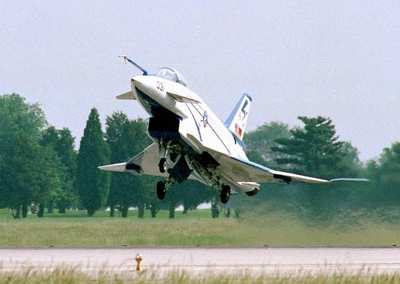 The Vectoring Extremely Short Takeoff and Landing
Control Tailless Operation Research (VECTOR) X-31 flight test
program completed the final flight of its lengthy "up-and-away"
test phase March 22, clearing the way for the final phase of flight
test to begin any day. By the end of April, the team hopes to have
flown the world’s first thrust-vectored, automated landings
on the runway.
The Vectoring Extremely Short Takeoff and Landing
Control Tailless Operation Research (VECTOR) X-31 flight test
program completed the final flight of its lengthy "up-and-away"
test phase March 22, clearing the way for the final phase of flight
test to begin any day. By the end of April, the team hopes to have
flown the world’s first thrust-vectored, automated landings
on the runway.
The X-31 uses thrust vectoring – controlling the direction
of its engine exhaust with paddle-like vanes to maintain control at
high angles of attack and reduced speeds, even well below the
typical landing speed for an aircraft of its type.

The Navy is using the X-31 to explore applications of thrust
vectoring technology for extremely short takeoff and landing
(ESTOL), with a particular eye toward the carrier landing
environment. Naval Air Systems Command (NAVAIR) has partnered on
the VECTOR program with Germany's Federal Office of Defense
Technology and Procurement, European Aeronautic Defence and Space
(EADS) Company and Boeing Aerospace.
In May, the test team began flying the "ESTOL up-and-away" test
phase, which centered around flying ESTOL approaches to a "virtual
runway" at 5,000 feet, successfully validating the technique.
During the 51 flights for “up-and-away” testing, X-31
test pilots flew ESTOL approaches at altitude to a maximum of 28
degrees angle of attack, said Doug Wilkin, lead flight test
engineer for VECTOR.

The X-31 is also being used as a test bed for EADS' Flush Air
Data System (FADS), a nose-mounted sensor that measures local
pressures used to calculate airspeed, angle of attack, sideslip and
altitude information, Wilkin said. The FADS has been hailed as a
more accurate, more stealthy alternative to the pitot static probes
and ports commonly used on aircraft today, he added.
German Naval Reserve Cmdr. Rüdiger Knöpfel closed out
ESTOL up-and-away March 22 with two supersonic flights focused on
assessing FADS performance. He reached speeds of Mach 1.06 and
1.18, in full afterburner at 39,000 feet, he said. While
supersonic, he induced combinations of angle of attack and side
slip to tax the FADS. By that night, Wilkin added, engineers had
processed the data and were able to confirm that the FADS was
performing as desired throughout the flight regime.

Another highlight of the up-and-away flight test phase was
flying the X-31 at 70 degrees angle of attack to gather FADS
performance data, Wilkin said. At 70 degrees angle of attack, the
X-31 can fly parallel to the horizon while its nose is pointed
almost straight up at the sky.
The X-31 is now being prepared for the final "ESTOL-to-ground"
test phase, in which Knopfel and his American counterpart, Marine
Corps Maj. Cody Allee, will guide the aircraft through its complex
ESTOL landing maneuver at increasing angles of attack and
associated reductions in speed.
Currently, the fly-by-wire X-31 is receiving a new software load
for its flight control computers, one that includes the control
laws for the ground landing. The team is also making slight
airframe modifications, and expects to begin flying again during
the first week of April, said Harvey Henn, flight test director.
They expect to accomplish all their goals within 14 flights, with
the first ESTOL landing occurring around the eighth flight, he
said.
Demonstrating the feasibility of thrust-vectored ESTOL landings
could give Navy planners an important set of options as they shape
acquisition decisions over the coming decades, program officials
believe. In the fleet, landings at reduced speeds and subsequently
higher angles of attack would impart significantly reduced forces
to both the aircraft and, in the case of carrier landings, the
arresting gear on the ship, said VECTOR Program Manager Jennifer
Young.

Besides reducing fatigue and increasing system life, such
reduced-energy landings would permit aircraft to land heavier,
bringing weapons and fuel back to the ship that might otherwise
need to be jettisoned, she explained. ESTOL may also have
applications for unmanned aerial vehicles. [ANN Thanks James Darcy,
Naval Air Station Patuxent River PA]
 SpaceX to Launch Inversion RAY Reentry Vehicle in Fall
SpaceX to Launch Inversion RAY Reentry Vehicle in Fall Aero-News: Quote of the Day (04.23.24)
Aero-News: Quote of the Day (04.23.24) Aero-News: Quote of the Day (04.20.24)
Aero-News: Quote of the Day (04.20.24) ANN's Daily Aero-Linx (04.20.24)
ANN's Daily Aero-Linx (04.20.24) Aero-News: Quote of the Day (04.21.24)
Aero-News: Quote of the Day (04.21.24)







